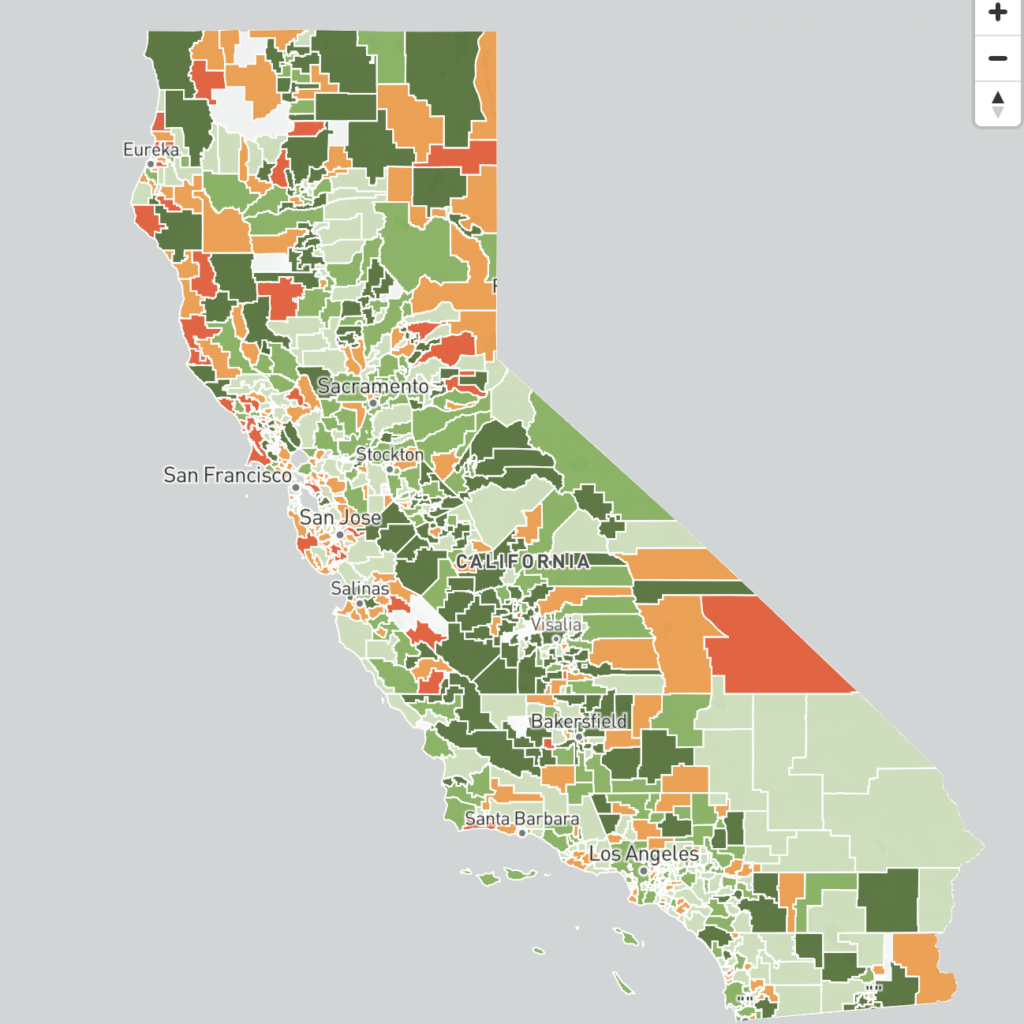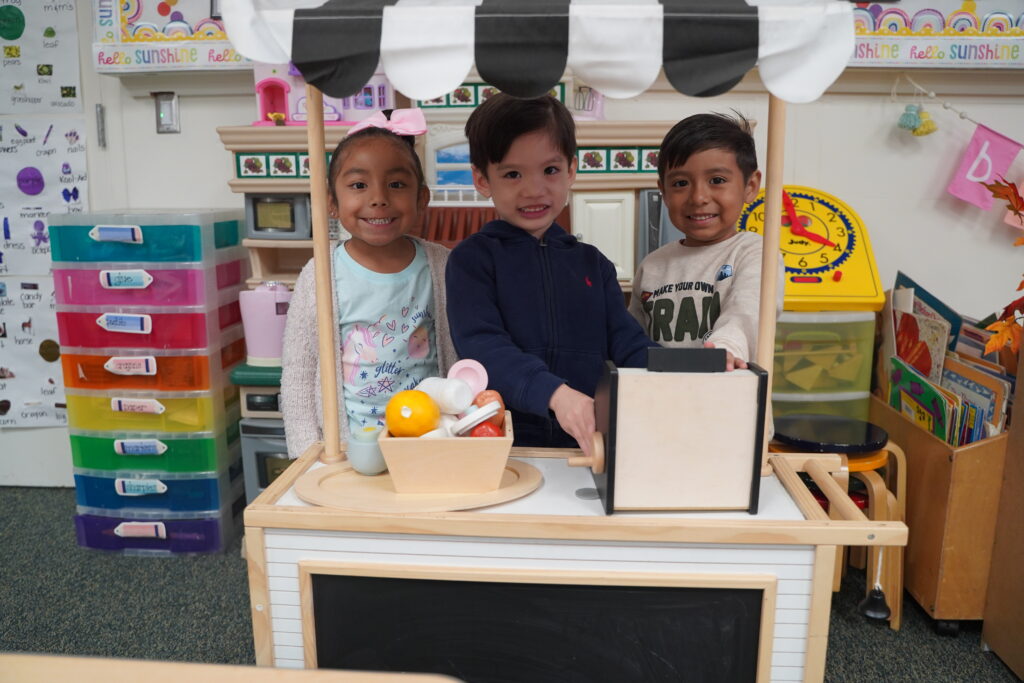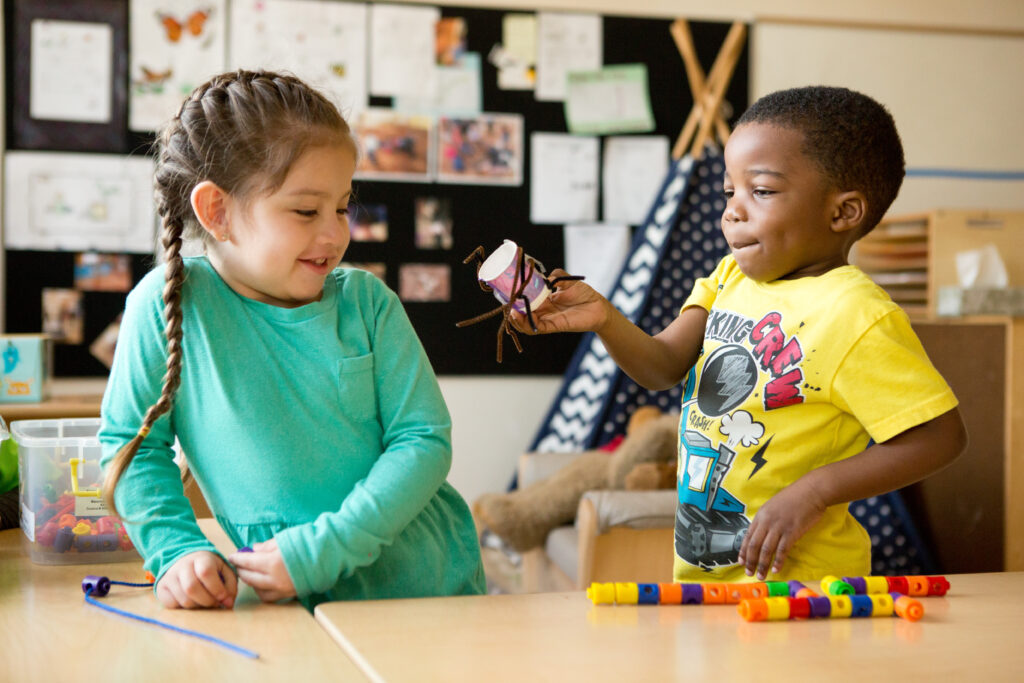
A preschool student shows his classmate a spider he made from pipe cleaners and a paper cup.
Credit: Allison Shelley/The Verbatim Agency for EDUimages
This is the second in a series of stories on how inadequate staffing may be impeding California’s efforts to offer high-quality instruction to all 4-year-olds by 2025.
Four-year-olds, many of whom have never attended school or day care, are entering California classrooms in droves following the state’s rapid expansion of transitional kindergarten, a grade preceding kindergarten.
In this grade known as TK, young students are exposed to academics and become familiar with letters, sounds and numbers. They also acquire social, emotional and intellectual skills through play and exploration. For example, from having to share toys with their peers in a structured environment, they learn to communicate with each other and handle conflict.
Once designed to serve only children who missed the kindergarten age cutoff, TK has evolved and is now projected to reach all the state’s 4-year-olds by the 2025-26 school year. TK is the first year of a two-year kindergarten program that uses a curriculum modified for the age and developmental level of the participating children. When fully implemented, California will have the largest universal preschool program in the nation, serving nearly 400,000 children.
Expanding TK: The age cutoff
According to the California Department of Education, California children who turned 5 between Sept. 2, 2022 and April 2, 2023 were eligible for TK this school year. For the 2024–25 school year, children who turn 5 between Sept. 2 and June 2 will be eligible. Students who turn 4 by Sept. 1 will be eligible during the 2024-25 school year.
Some of the state’s largest school districts, including Los Angeles Unified and Fresno Unified, are ahead of the state’s timeline in offering that access.
Fresno Unified operates 116 transitional kindergarten classes. Los Angeles Unified has not released the number of TK classes it offers, but according to district data, they serve nearly 11,000 students.
Though imperative for students, the expansion has created a problem: Some districts are not staffing TK classrooms with enough adults to maintain the required 1:12 staff-student ratio, a problem that educators say puts the 4-year-old pupils at risk, hampers learning and violates state legislation.
Twenty schools in LAUSD have been cited by the state for understaffing classes and violating the ratio.
Teachers told EdSource that 4-year-olds can’t learn if they aren’t safe and properly supervised by adults, and that not having enough adults in the classroom jeopardizes children’s safety.
“If you’re one adult and you’re managing so many children that have never been to school before, there isn’t any teaching going on,” said David Hunter, a teacher in Fresno Unified who has taught TK for the last six years of a 17-year career. “You’re just keeping them safe as best as you can, but you’re not actually able to teach.”
School districts jeopardize state funding if they fail to meet the state-set TK requirements of the 1:12 staff-student ratio and the average class size of 24 kids.
Out of the 1,815 audit reports that the California Department of Education reviewed, just seven school districts and 16 charter schools have been fined and will lose thousands of dollars in funding from their Local Control Funding Formula for failing to meet the staffing ratios during the 2022-23 school year. Teachers and others in the classroom say that many more districts and charters are not meeting the requirements but are managing to avoid punishment.
Los Angeles Unified, which is facing multimillion dollar fines, considers being fined because the classes do not have one additional adult unfair, district leaders said at a board meeting earlier this year. Many other penalized districts blamed the national shortage of teachers and paraprofessionals while some districts were critical of the California Department of Education for not clearly outlining the requirements.
Some teachers, on the other hand, say that what is unfair is that TK classes are not being staffed as outlined by the legislation and to support the young students.
According to the Fresno Teachers Association, more than a dozen TK classes were not meeting staffing ratios during the 2022-23 school year, yet Fresno Unified was not fined. Fresno educators told EdSource that school districts that were not in compliance last year, such as Fresno Unified, escaped detection and fines because fiscal penalties are based on sample auditing that did not check every school.
“This is a systems issue,” Hunter said, “and I want to see the system be better for everyone.”
Why do TK classes need extra staffing?
The California Department of Education (CDE) has outlined numerous benefits to having a lower adult-to-student ratio in TK classes, including opportunities for individualized instruction, additional adult support and attention as well as supervision at all times.
Legislation requires district staff such as paraprofessionals to work alongside teachers to meet the ratio requirement and share responsibilities of serving the students.
On any given day, a TK student may need to use the restroom or have a potty accident; another may get sick and others will require different types of attention.
“How do you manage that when there’s one of you and 21 four-year-olds?” Hunter said. “You need another adult to help deal with those situations.”
Hunter said he taught a class of 21 TK students without an aide from August to December 2022 during the 2022-23 school year, the first school year after the state added fiscal penalties related to TK requirements.
He said a teacher and an aide can split a large class into small groups to foster individualized learning, improve student assessment and evaluation and, ultimately, educate the young students — things that won’t happen in one large group of up to 24 four-year-olds.
Verifying compliance is difficult
Going Deeper
Compliance with the TK staffing ratio requirement is based on adult counts taken on the last teaching day of each school month prior to April 15, typically from August to March. In evaluating ratio compliance, auditors must consider an aide’s daily or weekly schedule, class rosters and other documentation for each class, according to the audit guide.
State compliance with TK requirements is verified in a district’s annual audit at the end of the school year and is based on a representative sample of a district’s schools.
Schools that are out of compliance may go unchecked if the sampled schools in the district are compliant. Because the sampled schools meet compliance, even though other schools do not, some districts and charters avoid penalties.
Fresno Unified, Hunter’s district, was not one of the school systems fined. District spokesperson AJ Kato told EdSource that Fresno Unified has not had problems with meeting the requirements that other districts may be experiencing.
But that’s not what teachers say.
At least 13 classes, according to Fresno Teachers Association President Manuel Bonilla, only had one adult for more than 12 students.
“The district could have done a better job at hiring additional folks … or in an emergency term, having their administrative staff provide additional support, but that seemingly didn’t happen,” Bonilla said.
A Fresno Unified TK teacher and union leader surveyed his colleagues.
“They were out of compliance with the state, and ultimately the problem is that the students aren’t getting the additional support that’s necessary,” Bonilla added.
Hunter said this is the second consecutive school year he’s been teaching out of ratio.
This school year, Hunter has a part-time aide but is still out of ratio because he is the only adult for 16 students on days the aide isn’t scheduled to work.
Having a full-time aide, or the equivalent, he said, should be baseline and is mandated by law.
According to the state Education Department, to be counted in the staffing ratio, the “assigned” adult must be a district employee who is dedicated and available to all TK students the entire school day. Student teachers and volunteers do not count toward it, nor do staff such as a special education aide or speech therapist who are assigned to work with specific students.
Part-time aides can satisfy the classroom staffing ratio, but only if the working time equals 100% of the time of a full-time aide, according to the CDE. Because Hunter’s class has 16 students, he needs more than one part-time aide working enough hours to equal the hours of a full-time aide. He has only had one part-time aide this school year.
Laton Joint Unified was penalized $30,943 for having a 1:16 ratio last school year. The school had a paraprofessional scheduled for one hour, 45 minutes each day, and that person was not available for all students the entire school day, the audit report detailed.
There are also instances of aides being pulled for recess or cafeteria duty or other teaching responsibilities, removing that aide from the instructional minutes with students, teachers told EdSource.
“Rina,” a former TK teacher who asked to be identified only by her nickname, said that when she took a job at Ballington Academy in San Bernardino City Unified in the 2023-24 school year, the school’s one TK classroom had 18 students. Rina and her aide would align with state compliance for the 18 students. About a week before school started, Rina said the school informed her that the aide, though assigned to her TK students, would be pulled to other elementary classrooms whenever a teacher was absent.
“It was wrong,” she said. She only stayed in the position for about a week after school started.
Some schools and districts, such as Scholarship Prep Charter School in Oceanside, Pomona Unified in eastern Los Angeles County and Culver City Unified in Los Angeles County, said in their audit reports that staffing shortages resulted in their inability to comply with state guidelines.
But that’s no excuse, teachers say, because it’s up to district administration to recruit, hire and retain paraprofessionals, instead of making it the teacher’s problem, Rina said.
Some suggest that the problem with hiring and retaining paraprofessionals is the low compensation.
A preschool teacher’s aide at Ericson Elementary in Fresno Unified is not in the TK classroom but works with students who are the same age as those entering transitional kindergarten. Speaking with EdSource on condition of anonymity, she said aides, whether in the TK or preschool class, are dealing with the same challenge: subpar pay.
Throughout the day, especially when working in groups, she helps the preschoolers with writing their names and learning letters and numbers. At other times during the day, such as during reading time, the aide ensures students keep their hands to themselves and listen to the teacher. As an aide, she sees the impact and importance of her role.
“We’re like their (teacher’s) spine,” she said about paraprofessionals. “We’re there to support and help. We do so much for these kids.”
She is paid $15.90 an hour and has, over the last two years, questioned whether she should remain in the role.
“That’s not helping me,” she said. She’s had to take on side jobs in the district, such as at sporting events, or resorted to borrowing money from friends and family. “I have to buy food, pay bills and then, I have four kids.
“If they’re still going keep that low (salary), people are not going … to apply for a position as an aide.”
Can teachers do anything?
As a teacher who’s been working out of ratio, Hunter wants districts to be held accountable.
“There’s a mechanism there, and I’d like to see that enforced,” Hunter said about the fiscal penalties outlined in legislation.
While the only way to address the compliance is with fines — which Hunter called “reactive” — he said a tool to report violations throughout the year could push districts to comply sooner and stop teachers from working out of compliance.
Currently, there is no such system or tool.
And if teachers are providing instruction in classrooms that are out of compliance, they would not report the violation to the state, CDE spokesperson Scott Roark said via email.
“Complaints against a district, school, principal, teacher or school personnel are not within the jurisdiction of the CDE unless the complaint falls within the scope of the Uniform Complaint Procedures,” Roark said, explaining that the TK requirements are under local control, with each district’s school board having authority over the complaint process.
The same reasoning applies to a teachers union hoping to report compliance concerns or violations.
But the struggles teachers are experiencing shouldn’t detract from the importance of TK.
TK expansion is necessary; schools just need support
Patricia Lozano, executive director of the advocacy group Early Edge California and a champion for expanding transitional kindergarten, told EdSource last year about the importance of the program, including how it provides children who were infants during the pandemic with social and intellectual engagement as well as age- and developmentally-appropriate structure and routine to help them thrive.
Simply put, TK is imperative for students, said many teachers interviewed by EdSource.
Hunter, who has a background in early childhood education, said TK is vital for introducing students to what school is, for teaching socialization and exposing them to academics.
“Any child who’s been through TK is that much more ready to hit the ground running in kindergarten,” he said. “I just want to see the appropriate support that not only the state promised, but I want to see the districts live up to that support so we can show these learners the best we can.”



















